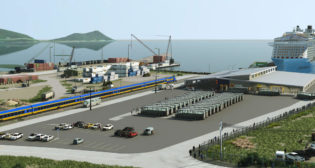
Making the Grade
Written by Marybeth Luczak, Executive Editor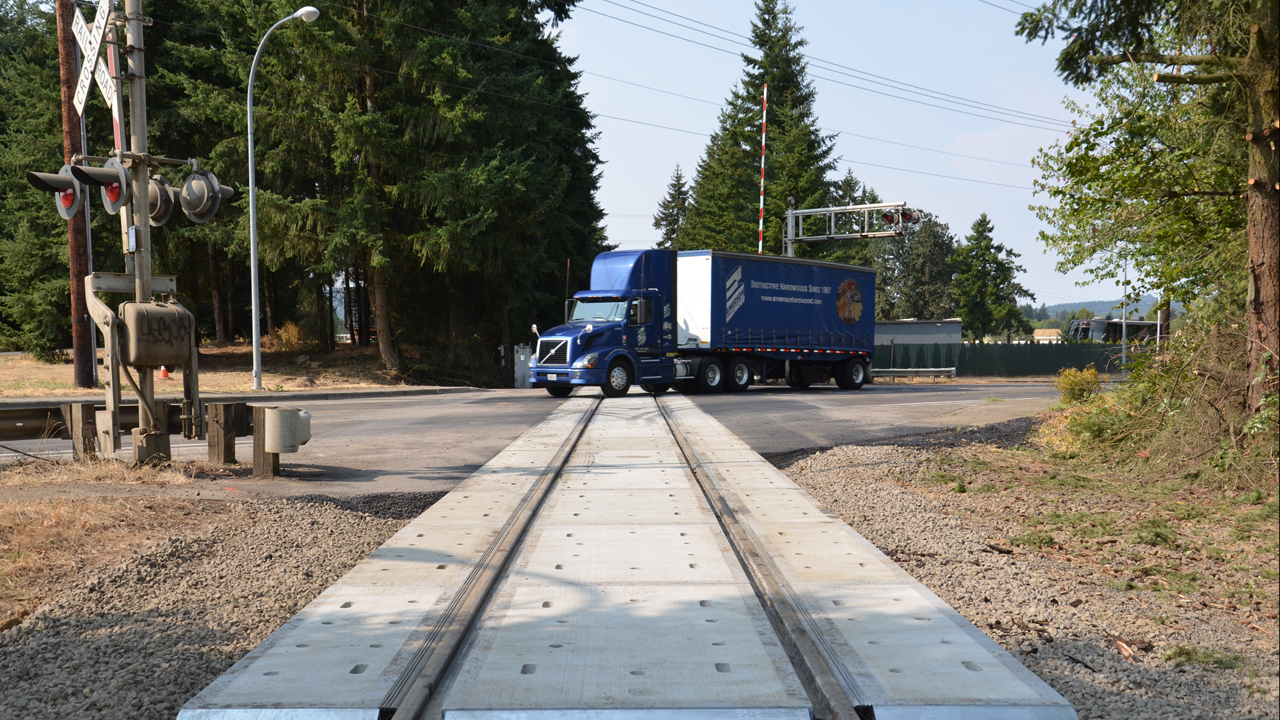
(Photograph Courtesy of Omega Industries Inc.)
RAILWAY AGE DECEMBER 2022 ISSUE: How suppliers are ensuring that crossing surfaces withstand heavy rail and road traffic—and meet customer expectations.
Concrete. Rubber. Composite. Timber. Grade crossing surface suppliers provide a number of solutions for the rail/road interface to withstand the long-term pounding of freight and passenger trains while providing a safe, smooth ride for motor vehicles, and to prevent trespassing.
While projects for Class I, II and III railroads and transit agencies are most common, those for intermodal and industrial applications are on the rise today. For the latest market trends and products in the pipeline, Railway Age turned to American Concrete Products, HiRAIL Corporation, L.B. Foster, Oldcastle Infrastructure, Omega Industries Inc., Omni Products Inc., and TieTek Global LLC for their insights. Here’s how 2022 is wrapping up and what’s in store for 2023 and beyond.
American Concrete Products
American Concrete Products precast crossings manufactured at plants in Nebraska, Kansas and Texas are in high demand, according to Vice President of Railroad Sales and Service Buz Hutchinson—especially for use at intermodal facilities being built or upgraded with longer sidings, and at manufacturing facilities just beginning to ship by rail or boosting those shipments. The company recently completed a project for a plastics producer in Chillicothe, Mo.
With this growth, customers are more frequently asking for shorter lead times as well as reduced pricing, Hutchinson reports. To support this, American Concrete Products is currently “looking at material changes that may allow us to increase the length of the written warranty—now 12 years—or to change the material without affecting the life expectancy of our product,” he says. The company may consider using stronger concrete, such as polymer concrete, and less steel, as steel costs have tripled in some cases. The work will be part of a long-term controlled study.
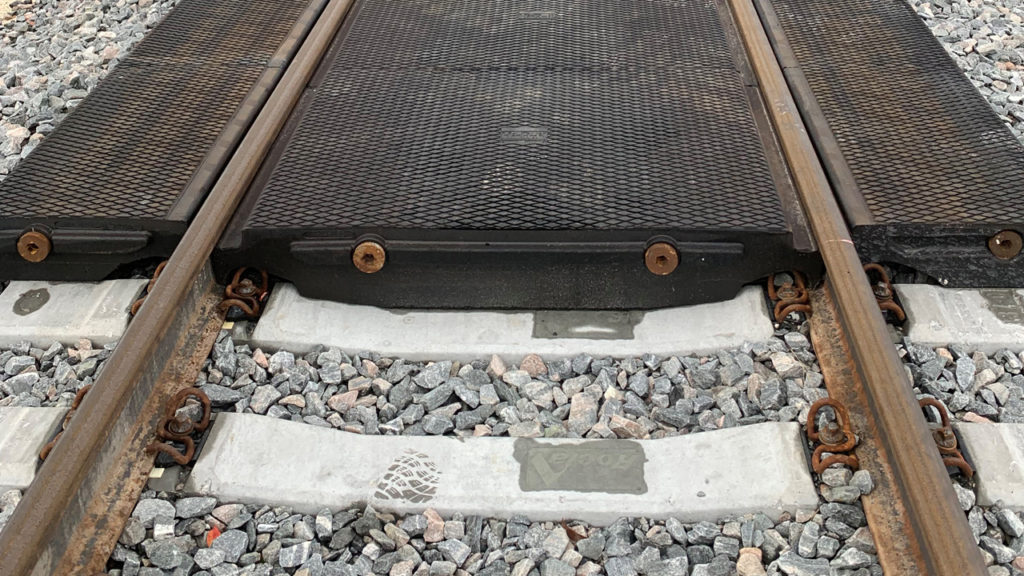
HiRAIL Corporation
HiRAIL Corporation crossing surfaces are manufactured from 100% molded rubber and incorporate recycled tires. Current market conditions remain strong in all sectors, from Class I’s, short lines and transit agencies to contractors and industry, according to Director of Sales and Marketing Jim Overfelt. “Like most businesses, we are cautiously optimistic that long-term demand will remain strong; however there is some concern with the slowing economy and how this will affect our customers’ crossing budgets,” he tells Railway Age.
The company is continuing its work developing new full-depth rubber crossing profiles to fit new concrete tie designs and new fastening systems. “The majority of the concrete ties produced domestically are not flat or rectangular-shaped like a timber tie,” Overfelt explains. “Most concrete ties have an area that slopes down from the rail seat toward the middle of the tie that meets a flat section in the middle. Over the course of many years, the concrete tie manufacturers have made these areas different lengths. As these dimensions change, we change to make our product fit the contour of the concrete tie. Our design capabilities allow the client to use the same concrete tie profile throughout their entire system and not have to transition to flat concrete ties or timber ties for their crossings. On top of the changes in shape, there have also been new fastening systems introduced that require us to add more clearance. Consequently, we end up changing our design to fit these requirements. We also seem to be getting more inquires for direct-fixation track crossings, which require a lot of the same design capabilities that we use for concrete or steel tie crossings.”
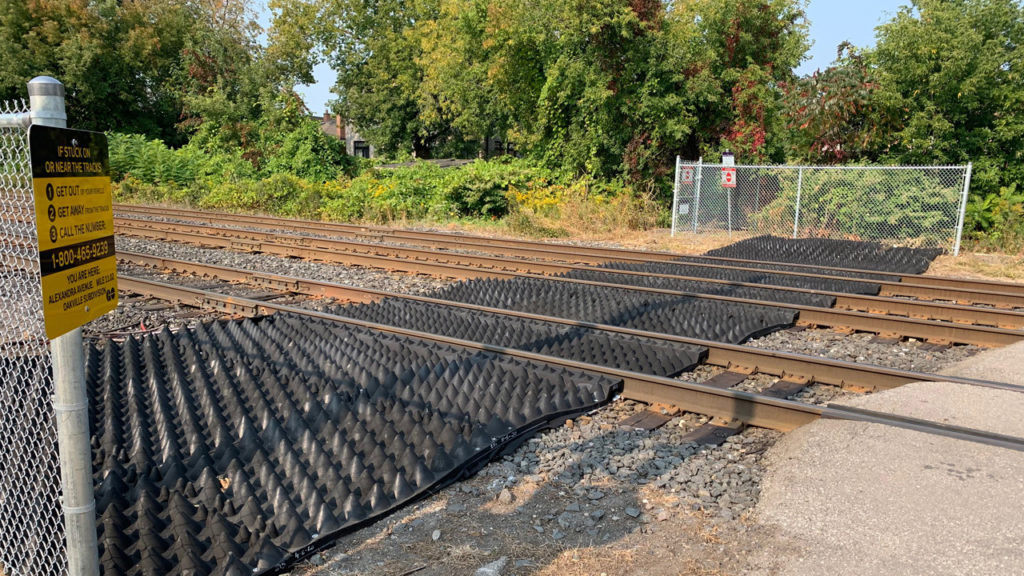
L.B. Foster
L.B. Foster is the North American distributor of the Rosehill Rail grade crossing panel and anti-trespass panel systems made from raw materials reclaimed from truck and car tires. “Our suite of products accommodates applications for heavy duty, light use, road-rail vehicle access and pedestrian crossings suitable for all rail, sleeper/tie and fastening combinations,” General Manager, Transit Products Sarah McBrayer tells Railway Age.
Anti-trespass panels not only serve as a physical and visual deterrent to prevent pedestrian foot traffic and animal crossings, but also “are proven to reduce incidents by up to 80%,” according to McBrayer. They can be used in conjunction with grade crossing panels or as a stand-alone product at stations, on bridges and overpasses, around pedestrian crossing areas, and as an alternative to cattle guards or other livestock or wildlife crossing prevention systems. L.B. Foster recently installed them at a remote U.S. transit agency station to prevent hikers from accessing the track near a popular trailhead access point, and it wrapped up a three-year project for a Canadian transit agency implementing the panels at a number of high-risk pedestrian crossing areas.
How are market conditions today for L.B. Foster offerings? The company “did see a delay on some planned projects over the past couple of years due to COVID and reduced ridership, but these projects have picked back up in the latter part of this year,” says McBrayer, who notes that longer-term, as markets continue to rebound from the pandemic and supply chain shortages, there will be “a refocused effort on safety initiatives.”
Customers, she adds, are looking for “low-maintenance safety products that can reduce pedestrian crossing incidents.” L.B. Foster’s “sustainable, environmentally friendly, 100% recycled tire product is also plus,” she says.
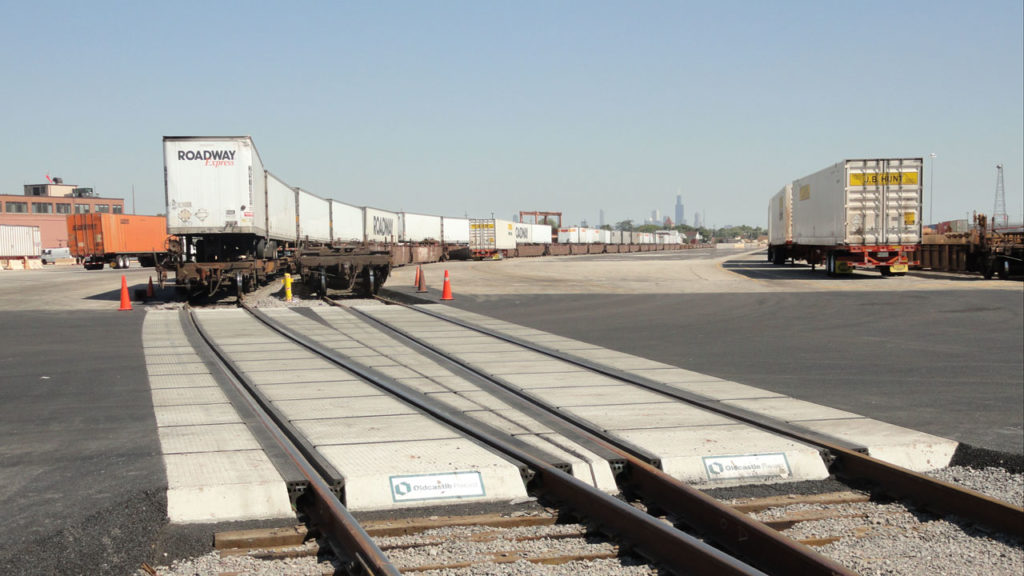
Oldcastle Infrastructure
At Oldcastle, demand continues for its Heavy Duty Crossings for port, intermodal and industry, as well as Standard Duty Crossings for the rail transit sector, according to National Accounts Manager, StarTrack Rail Products Wayne Wendel. The precast concrete products do not require crossties or ballast; include a rubber rail groove for access without disassembly, abrasion strips, embedded Pandrol shoulders, and galvanized e-clip fasteners; and offer a diamond-plate anti-skid surface.
“We are currently working on projects for the Port of Long Beach, and at various locations for BNSF, Union Pacific, Norfolk Southern and CN,” Wendel tells Railway Age. “We are also working on projects for New Jersey Transit, RTD (Denver, Colo.), and Metro Transit (Minnesota), to name just a few.”
While raw materials and supply chain issues are still affecting production, he says, they do seem to be lessening. The company is “currently working toward stabilizing and diversifying our raw material chain, and getting stock levels back up to better respond to demand. Oldcastle is constantly looking for innovation, not just in the rail sector, but in all of the markets we serve,” according to Wendel.
Omega Industries Inc.
Omega has also seen raw material costs “skyrocket over the past two years, though price increases don’t seem to have affected grade crossing panel demand,” the company tells Railway Age. “As long as there are highway/rail grade crossings—and there are an estimated 200,000 public crossings in the U.S.—demand for surface maintenance materials will continue.”
Like highways, bridges, crossties and rail, grade crossing surfaces eventually wear out and need to be replaced. “Many crossings that were upgraded 20-25 years ago are starting to wear, and the cycle is beginning again,” according to Omega, which says annual demand should continue.
Railroads and rail contractors are more often asking for “speedy delivery,” Omega reports, so “short lead times have been key.” The company is currently supplying crossing panels to the Class I’s as well as a host of short lines and contractors, as well as the Dallas Area Rapid Transit (DART) Silver Line in Texas; Southwest Light Rail in Minnesota; Metro Foothill Gold Line in Southern California; and Sound Transit in Seattle, Wash.
What products are in the pipeline? “We are currently testing new concrete additives that will increase panel durability and minimize water penetration and reinforcement corrosion,” Omega reports. “We’ve replaced our galvanized steel lifting eyes with stainless steel, and are in the process of replacing galvanized steel lag screw liners with non-corrosive, non-conductive polyresin liners.” On the R&D side, the company continues “to watch for new concrete technologies and practices, so we can provide our customers with a durable, long-lasting product.”
Omni Products Inc.
Omni Products manufactures a variety of panels, including the ECR (Embedded Concrete-Rubber), which is designed with the rubber flange seal molded into the face of the steel-clad, steel-reinforced concrete panels, and the IC (Improved-Concrete), which incorporates rubber RailGuard panels with precast concrete panels.
Work for the first half of 2022 was slower than normal, Rob Greenside, Sales Manager-Midwest, South Central and West Coast, tells Railway Age. More than 50% of the company’s larger jobs planned for the year were postponed until 2023, due to raw material and trucking price increases. “Steel costs rose continuously from April until July,” says Greenside, who adds that costs have since stabilized and are expected to remain constant at least until early 2023. Product delivery logistics have been a challenge, too, he says, because much of the company’s jobs are not in urban areas “or where truck drivers could make a ‘swing by’ to pick up another load, thereby making it worth their while. But, I think this year was just an exception, not the rule. I think our longer-term outlook is going to be positive as far as market conditions go.”
Greenside reports that Omni uses a solid virgin, molded rubber—not extrusion—for its crossing panels. The company manufactures it for the IC product and specifies it for the ECR product. Why? Because it “is going to last longer, and when it’s installed, you don’t have any issues with rubber coming apart or tearing,” he says.
Now that it’s winter, the company is “outsourcing as many of its products as possible to build up an inventory so that we’ll be ready [for projects] as soon as the weather breaks in spring,” Greenside says. And “trying to improve manufacturing methods in order to meet customer delivery times is going to be something that we, or anybody else for that matter, is going to have to improve on in the future,” he adds.
TieTek Global LLC
A subsidiary of EFG Composites, TieTek Global offers a “Complete Composite Highway-Rail Grade-Crossing System” comprising Endurance®-XL Composite Panels and TieTek® Engineered Polymer Composite Cross Ties. The use of TieTek composite crossties under Endurance composite crossing panels extends the service life of Endurance Composite Crossings, according to Vice President, Sales and Marketing Linda Thomas. “Endurance-XL Composite Crossings utilize durable, recycled polymer materials and can be installed in a wide variety of applications,” she says. “Panels are supplied in 8-foot, 1-1/2-inch lengths for 19-1/2-inch tie spacing, and manufactured in 6-foot, 7-1/2-inch and 8-1/4-inch heights for use with most rail sizes and fastening systems. The panels can be lagged down to 8-foot, 6-inch or 10-foot treated wood or TieTek composite crossties. Panels are supplied pre-drilled with an option for drilling on-site for installation on curved track or when routine maintenance is required. Optional rubber flangeway filler, lag screws and TieTek composite ties complete the package.”
Driving product demand today are not only transit, port and industrial growth and new infrastructure projects, but also user “corporate sustainability goals and the desire to utilize durable ‘green’ products with a proven performance history,” Thomas says. Endurance crossing panels and TieTek ties both can be recycled “at the end of their useful lives,” she adds. TieTek Global plans to reintroduce Endurance-XL Plus grade crossings early next year.
TTC/ENSCO
To evaluate and demonstrate emerging safety technologies, the U.S. DOT Transportation Technology Center (TTC) is planning a “grade crossing test bed” in Pueblo, Colo. While new site manager ENSCO, Inc., isn’t able to provide details yet to Railway Age, the test bed is expected to launch in 2023. Stay tuned.



